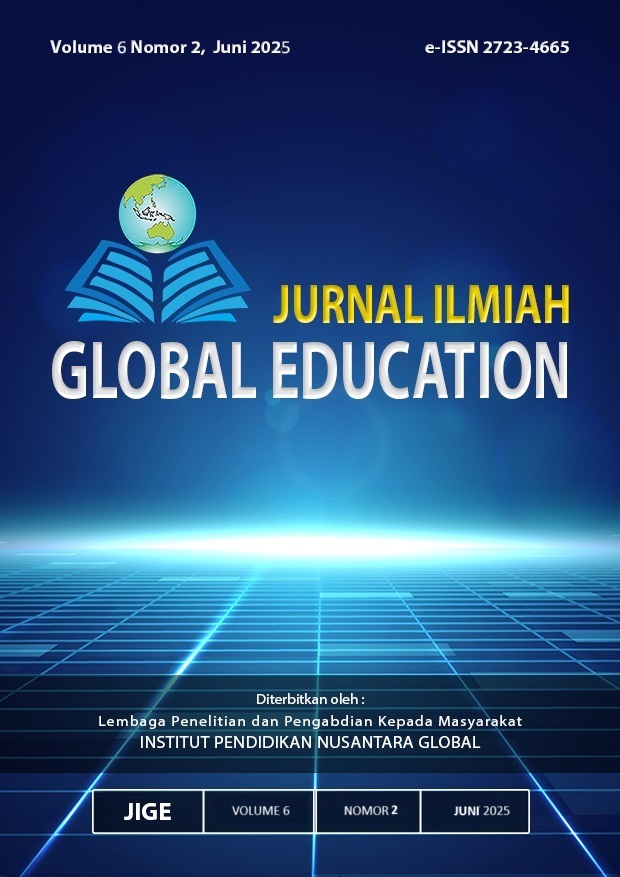Analisis Penerapan Kuota Gender Kandidat Perempuan Partai Keadilan Sejahtera Pada Pemilihan Umum Legislatif 2024
DOI:
https://doi.org/10.55681/jige.v6i2.3730Keywords:
Legislative Election in 2024, Prosperous Justice Party, Gender Quota for Female Candidates, Motivation, Party EliteAbstract
This study aims to discuss the perspective of the Prosperous Justice Party in maximizing the 30% gender quota for female candidates in all electoral districts in the 2024 legislative elections. The purpose of the study is to analyze the political phenomenon of the Prosperous Justice Party which is the only political party among 18 (eighteen) political parties that can fulfill the 30% quota for female legislative candidates in all electoral districts in the 2024 legislative elections. This study uses a qualitative approach with a descriptive research type. Data collection is sourced from primary data through in-depth interviews with several informants. While secondary data comes from literature studies, both relevant books and articles, documentation in the form of laws and regulations related to legislative elections. In answering the research problems, the researcher uses the theory of gender quotas for female candidates and the concept of women's representation in parliament. The results of the study show that the Prosperous Justice Party has succeeded in implementing a gender quota of 30% for female candidates in the 2024 Legislative Elections as mandated by Law Number 7 of 2017 concerning Elections, Article 245. The success of the Prosperous Justice Party is in line with the party's motivation to be more female-friendly, both through work programs, female cadre formation to fill strategic positions within the party, and open institutionalization of female cadres as party elites.
Downloads
References
Aminah, Sri Mulyani, Ubaidullah (2020), Pola Rekrutmen Bacaleg Perempuan Partai Keadilan Sejahtera pada Pemilu 2019 di Kota Banda Aceh.
Ana Sabhana Azmy, Isnaini Anis Farhah (2018), Partai Politik dan Keterwakilan Perempuan (Analisis Problematika Partai Politik dalam Memenuhi Keterwakilan Perempuan di DPRD), Jurnal Harkat: Media Komunikasi Gender, 14(1), 75-83
Andie Hevriansyah (2021), Hak Politik Keterwakilan Perempuan dalam Sistem Proposional Representatif pada Pemilu Legislatif, Jurnal Pemilu dan Demokrrasi Vol 1, No.1
Andrew Reynolds, "Merancang Sistem Pemilihan Umum" dalam Juan J. Linz, dkk., Menjauhi Kaum Penjahat: Belajar dari Keheliruan Negara-negara Lain, (Bandung: Mizan,2001)
Ashiddiqie. Hak Konstitusional Perempuan dan Tantangan Penegakannya., vol. 7, 2017.
Celis, K., Krook, M. L., & Meier, P. (2014). The rise of gender quota laws: Expanding the spectrum of determinants for electoral reform. In Understanding Electoral Reform (pp. 78-94). Routledge.
Citra N Fariaty (2022), Peran Partai Politik Untuk Mendorong Keterwakilan Perempuan Di DPRD Kabupaten Mamasa Tahun 2019, Musamus Journal Of Public Administration.Vol IV, No 2.
Creswell. 2010. “Research Design: Pendekatan Kualitatif, Kuantitatif, dan mixed. Yogyakarta: PT Pustaka Pelajar
Erwin Surva (2023), Pemberdayaan Perempuan Dalam Politik: (Analisis Gender dan Kekuasaan), Vol. 1 No. 2.
Höhmann, D. (2021). Electoral Incentives, Critical Actors, and the Substantive Representation of Women in Parliament (Doctoral dissertation, Otto-Friedrich-Universität Bamberg, Fakultät Sozial-und Wirtschaftswissenschaften).
https://cakrawikara.id/wp-content/uploads/2020/02/PPT-CWI-KPP-RI-17-Feb-2020.pdf
https://infid.org/siaran-pers-parpol-tidak-penuhi-minimal-30-caleg-perempuan-harus-didiskualifikasi/
https://infopemilu.kpu.go.id/Pemilu/Dct_dpr
Krook, Mona Lena, Quotas for Women in Politics: Gender and Candidate Selection Reform Worldwide, Oxford University Press: London, 2009.
Kurniawan, N. (2014). Keterwakilan Perempuan Di Dewan Perwakilan Rakyat Pasca Putusan Mahkamah Konstitusi Nomor 22-24/PUU-VI/2008. Jurnal Konstitusi, 11(4), 714-736. doi:https://doi.org/10.31078/jk1146
M. Teguh Setyadi Bahtiar, Fadlan Akbar, Febrianto Syam (2021). Hak dan Keterwakilan Politik dalam
Matland, R. E. (2005). Enhancing women’s political participation: legislative recruitment and electoral systems. Women in parliament: Beyond numbers, 2, 93-111.
Norris, P. (2006). The impact of electoral reform on women's representation. Acta política, 41, 197-213.
Nurdin (2021), Keterwakilan Politik Perempuan di Parlemen Periode 2019-2024: Peran Partai Politik, Journal of Politics and Democracy, Vol.2
Parid Sidik (2022), Keterwakilan Perempuan dalam Politik di Indonesia Prespektif Legal Feminism, vol.2, No.1
Samuel P Huntington, Gelombang Demokratisasi Ketiga, (Jakarta: Grafiti, 1997),
Sigmund, Neumann. 1963. “Modern Political Parties”, Comparative Politics: A Reader, diedit oleh Harry E. Eckstein dan David E. Apter. London: The Free Press of Glencoe
Siti Aminah, Emmy Solina, Tyka Rahman, Indah Sari Rahmaini (2021), Strategi Partai Politik Untuk Meningkatkan Keterwakilan Perempuan dalam Kontestasi Pemilihan Anggota DPRD Kota Tanjung Pinang, Jurnal Masyarakat Maritim.
Sugiyono. (2013). Metode Penelitian Kuantitatif, Kualitatif, dan R&D. Bandung: Alfabeta
Suyatno. (2015). “Metode Penelitian Sosial: Berbagai Alternative Pendekatan”. Jakarta: Prenada Media
Thames, F. C., & Williams, M. S. (2010). Incentives for personal votes and women’s representation in legislatures. Comparative Political Studies, 43(12), 1575-1600.
Undang-Undang Nomor 10 Tahun 2008 Tentang Pemilihan Umum Anggota Dewan Perwakilan Rakyat, Dewan Perwakilan Daerah, dan Dewan Perwakilan Rakyat Daerah.
Undang-Undang Nomor 12 Tahun 2003 Tentang Pemilihan Umum Anggota Dewan Perwakilan Rakyat, Dewan Perwakilan Daerah, dan Dewan Perwakilan Rakyat Daerah.
Undang-Undang Nomor 7 Tahun 2017 Tentang Pemilihan Umum.
Undang-Undang Nomor 8 Tahun 2012 Tentang Pemilihan Umum Anggota Dewan Perwakilan Rakyat, Dewan Perwakilan Daerah, dan Dewan Perwakilan Rakyat Daerah.
Wängnerud, L. (2009). Women in parliaments: Descriptive and substantive representation. Annual Review of Political Science, 12(1), 51-69.
Downloads
Published
How to Cite
Issue
Section
License
Copyright (c) 2025 Wahyu Gunawan, Nurdin

This work is licensed under a Creative Commons Attribution-ShareAlike 4.0 International License.












